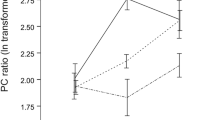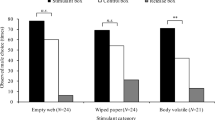Summary
This study investigated differential attraction of estrous brown lemmings (Lemmus trimucronatus) to conspecific males recently exposed to each other for a 10-min agonistic encounter. In tests conducted 5 min, 1 h and 24 h after agonistic encounters, females preferred the oder of dominant males to that of defeated males when both odors were presented simultaneously in a Y-maze olfactometer. Defeat in an agonistic encounter did not reduce the propensity of male lemmings to initiate sexual behavior. In one-male, one-female tests conducted 5 min after agonistic encounters, dominant males achieved higher mount and thrust scores while defeated males obtained higher scores for attempted mounts. The sexual behavior of dominant and defeated males did not differ significantly in similar tests conducted 1 h and 24 h later. In contrast, females readily mated with dominant males and tended to avoid defeated males in two-male tethering tests conducted 5 min after agonistic encounters. In these tests, females still showed a preference for dominant males 1 h and 24 h after male agonistic encounters.
Similar content being viewed by others
References
Banks EM, Brooks RJ, Schnell J (1975) A radiotracking study of home range and activity of the brown lemming (Lemmus trimucronatus). J Mammal 56:888–901
Bronson FH (1973) Establishment of social rank among grouped male mice: relative effects of circulating FSH, LH, and corticosterone. Physiol Behav 10:947–951
Bronson FH, Stetson MH, Stiff ME (1973) Serum FSH and LH in male mice following aggressive and nonaggressive interactions. Physiol Behav 10:369–373
Buhl AE, Hasler JF, Tyler MC, Goldberg N, Banks EM (1978) The effects of social rank on reproductive indices in groups of male collared lemmings (Dicrostonyx groenlandicus). Biol Reprod 18:317–324
Calhoun JB (1962) The ecology and sociology of the Norway rat. US Dept Health, Education, and Welfare, Bethesda, Maryland
Carr WJ, Martorano RD, Krames L (1970) Responses of mice to odors associated with stress. J Comp Physiol Psychol 71:223–228
Carr WJ, Roth P, Amore M (1971) Responses of male mice to odors from stressed vs nonstressed males and females. Psychon Sci 25:275–276
Christian JJ (1970) Social subordination, population density, and mammalian evolution. Science 168:84–90
Christian JJ, Lloyd JA, Davis DE (1965) The role of endocrines in the self-regulation of mammalian populations. Rec Prog Horm Res 21:501–571
Daly M, Wilson M (1978) Sex, evolution, and behavior: Adaptations for reproduction. Duxbury, North Scituate, Massachusetts
DeFries JC, McClearn GE (1970) Social dominance and Darwinian fitness in the laboratory mouse. Am Nat 104:408–411
DeFries JC, McClearn GE (1972) Behavioral genetics and the fine structure of mouse populations: A study in microevolution. In: Dobzhansky T, Hecht MK, Steere WC (eds) Evolutionary biology. Appleton-Century-Crofts, New York, pp 179–291
Dewsbury DA (1979) Copulatory behavior of deermice (Peromyscus maniculatus): II. A study of some factors regulating the fine structure of behavior. J Comp Physiol Psychol 93:161–177
Halliday TR (1978) Sexual selection and mate choice. In: Krebs JR, Davies NB (eds) Behavioural ecology: An evolutionary approach. Blackwell, Oxford, pp 180–213
Horn JB (1974) Aggression as a component of relative fitness in four inbred strains of mice. Behav Genet 4:373–381
Huck UW, Banks EM (1979) Behavioral components of individual recognition in the collared lemming (Dicrostonyx groenlandicus). Behav Ecol Sociobiol 6:85–90
Huck UW, Banks EM (1980) The effects of cross-fostering on the behaviour of two species of North American lemmings, Dicrostonyx groenlandicus and Lemmus trimucronatus: II. Sexual behaviour. Anim Behav 28:1053–1062
Huck UW, Banks EM (1982) Male dominance status, female choice and mating success in the brown lemming, Lemmus trimucronstus. Anim Behav 30:665–675
Huck UW, Carter CS, Banks EM (1979) Estrogen and progesterone interactions influencing sexual and social behavior in the brown lemming, Lemmus trimucronatus. Horm Behav 11:40–49
Huck UW, Banks EM, Wang S-C (1981) Olfactory discrimination of social status in the brown lemming. Behav Neural Biol 33:364–371
Levine L (1958) Studies on sexual selection in mice: I. Reproductive competition between albino and black-agouti males. Am Nat 92:21–26
Levine L, Lascher B (1965) Studies on sexual selection in mice: II. Reproductive competition between black and brown males. Am Nat 99:67–72
McKinney TD, Desjardins C (1973) Intermale stimuli and testicular function in adult and immature mice. Biol Reprod 9:370–378
Orians GH (1969) On the evolution of mating systems in birds and mammals. Am Nat 103:589–603
Trivers RL (1972) Parental investment and sexual selection. In: Campbell BC (ed) Sexual selection and the descent of man. Aldine, Chicago, Illinois, pp 136–179
Vale JR, Lee C, Ray D (1970) The effect of defeat upon the reproductive biology and upon adrenal, testes and seminal vesicles weights of C57BL/6 mice. Commun Behav Biol 5:225–236
Wilson EO (1975) Sociobiology: The new synthesis. Belknap, Cambridge, Massachusetts
Author information
Authors and Affiliations
Rights and permissions
About this article
Cite this article
Huck, U.W., Banks, E.M. Differential attraction of females to dominant males: Olfactory discrimination and mating preference in the brown lemming (Lemmus trimucronatus). Behav Ecol Sociobiol 11, 217–222 (1982). https://doi.org/10.1007/BF00300064
Received:
Accepted:
Issue Date:
DOI: https://doi.org/10.1007/BF00300064




